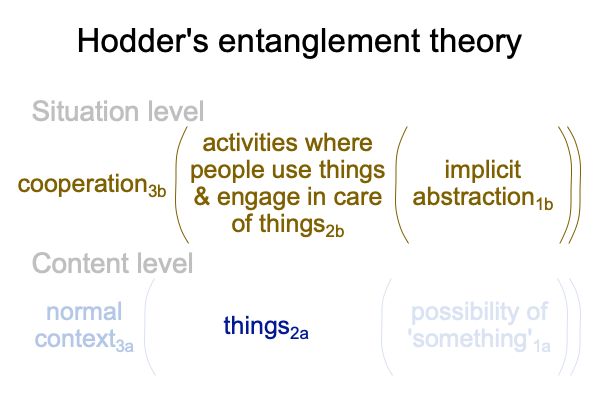0068 From the prior blog, I know that Hodder’s entanglement theory indirectly describes a human adaptation2b. This adaptation2b exploits a niche1b in the normal context of natural selection3b. The human niche1b is the potential of triadic relations1b.
Triadic relations2a are purely relational beings. They rely on material beings. But, they are not material beings. They are like things, in the sense that they exist in the environment of evolutionary adaptation. They are not mere things, like boulders resting on a valley floor. They are like boulders changing the way that water flows in a river. They are relational beings.
0069 Hodder writes as if things entangle us. He wants to extend the idea to biological evolution. Things create potentials1b that may be exploited by adaptations2b in the normal context of natural selection3b.
But the inverse is also true. Life searches for opportunities to stay alive. Life seeks ways to avoid death. Sometimes, things provide those opportunities. Sometimes, things provide dangers. We know this in our bones. Potential may be opportunity. Potential may be dangerous.
Consequently, entanglement theory should fall into our mind’s lap, like manna from heaven.
0070 These comments add value to Hodder’s work. Here is a way to articulate Hodder’s entanglement theory.

0071 Hodder refines his theory by isolating various dependencies. Human-thing dependence is H2b-T2a. Thing-human dependency, T2a-H2b, is an instance when the content-level normal context3a and potential1a come into play as a projection of implicit awareness1b. Thing2a-thing1b dependency describes the nature of tools.
These dependencies are salient in the Lebenswelt that we evolved in.
0072 Oh, I almost neglected to mention one more dependency. Human-human dependency.
Now, this dependency is like all the other dependencies. At the same time, H-H dependency is not the same as all the other dependencies. How so? One of the elements of H-H must be a thing. One element changes from a human to a thing. This transformation characterizes explicit abstraction. In this regard, all the other dependencies may be re-enacted with specialized humans as things.
H-H dependency is salient in our current Lebenswelt.
0073 Plus, our current Lebenswelt is not the same as the Lebenswelt that we evolved in.
